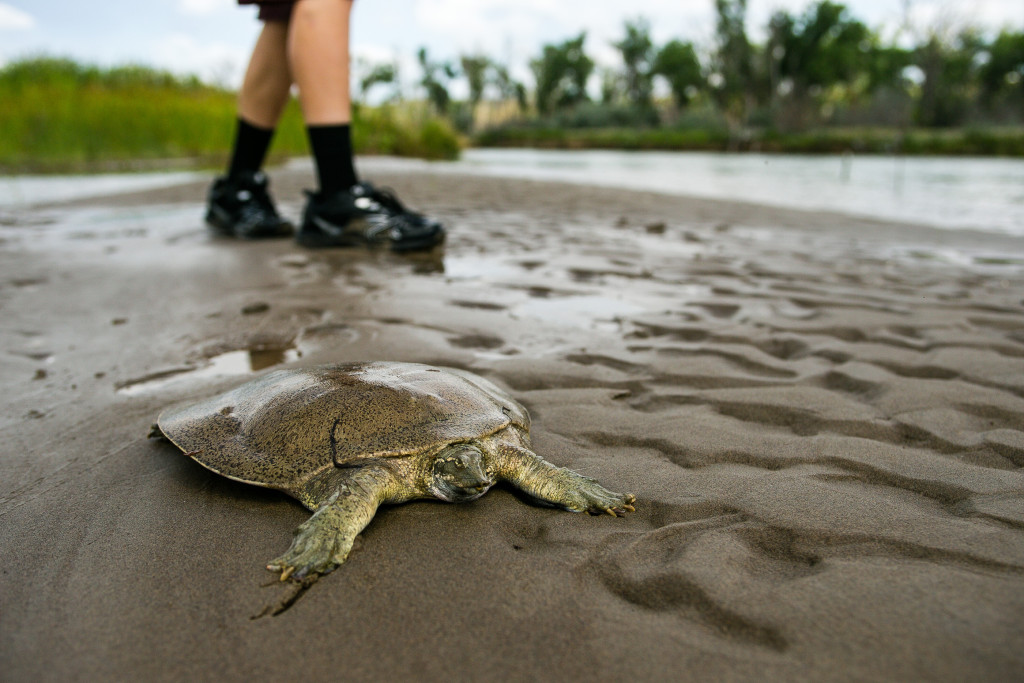
By Monica Macoubrie, Wildlife Education Specialist
Turtles are some of the oldest living and unique animals on the planet. Let’s start with the obvious: their shell. A turtle shell is unlike any other physical, protective device found on an animal. Most turtles have a hard shell made from beta keratin. These hard shells are covered in scutes, similar to scales, which gives them rigidity for protection. But not all turtles have hard shells. Nebraska is home to two species of softshell turtles with flexible, leathery carapaces (top shell) made of alpha keratin. For protection, some turtles have two hinges on their shells that allow them to almost completely disappear inside, while other turtle shells have a single hinge, which enables the animal to retreat only partially. A turtle’s habitat will largely determine the type of shell it has.
Another key feature in turtles is their beak, or tomia. Turtles do not have teeth, so instead rely on their hard upper and lower jaws composed of a keratinous sheath, the same material that make up their shells. This “beak” is efficient at chopping vegetation and other foods into bite-sized pieces.
The world is home to around 330 species of turtles, and Nebraska houses nine of those species. Let’s take a quick look at the turtles that call our beautiful state home.
Common Snapping Turtle (Chelydra serpentina)
The common snapping turtle is not only Nebraska’s largest species of turtle, but it also has some interesting characteristics: a large head; an incredibly long tail; distinct, sawtooth-like projections toward the back of its carapace; and a highly reduced plastron, or bottom part of the shell. Although this smaller plastron doesn’t offer comprehensive protection, the snapper’s powerful jaws makes up for the shortage. To hunt, snapping turtles use a “sit and wait” strategy, patiently buried in mud underwater until food comes floating near.
Size wise, it is not unusual for people to see individuals larger than a platter and weighing more than 50 pounds wandering down the road.
Females normally nest in May and June and can travel far distances from any water source to lay their eggs. Young turtles will then hatch between August and October to about the size of a quarter, with a tiny shell which they will grow into.
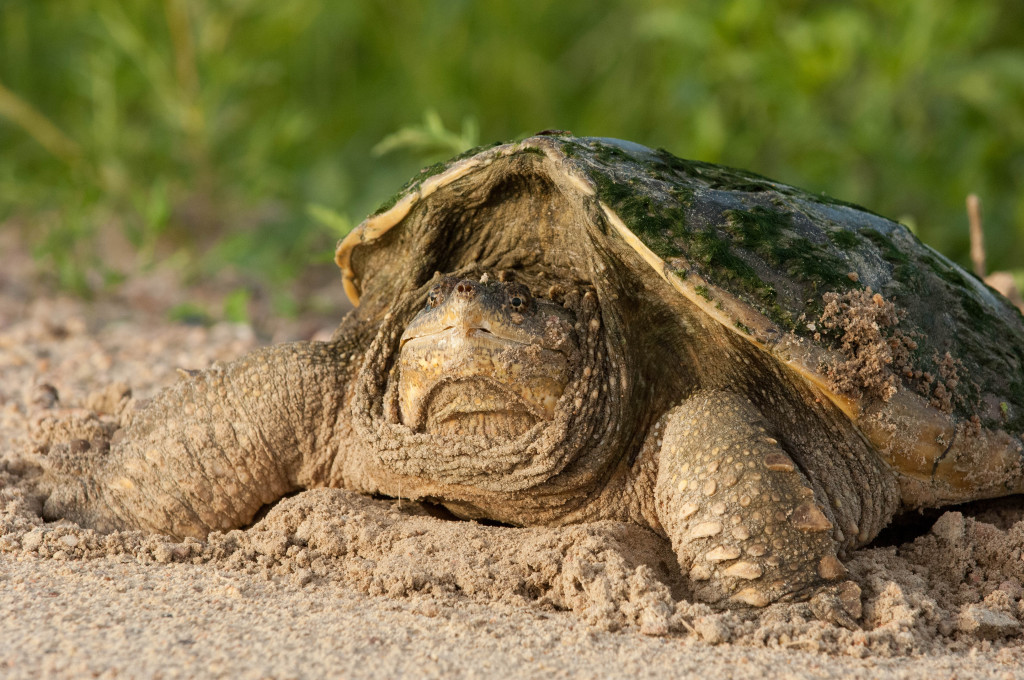
Painted Turtle (Chrysemys picta)
The painted turtle is probably the most seen turtle in the state and can be found in just about any body of water. They are often the first turtles seen in the spring, basking on logs, rocks and even on top of each other in the warm sun. They get their name from the yellow and red blotches on their plastrons, which gives them a painted–like appearance. These turtles are omnivorous; their diet consists of roots and leaves of submerged vegetation, invertebrates, fish and tadpoles. Eggs hatch by early fall, but hatchlings nearly always overwinter and do not emerge until the following spring.
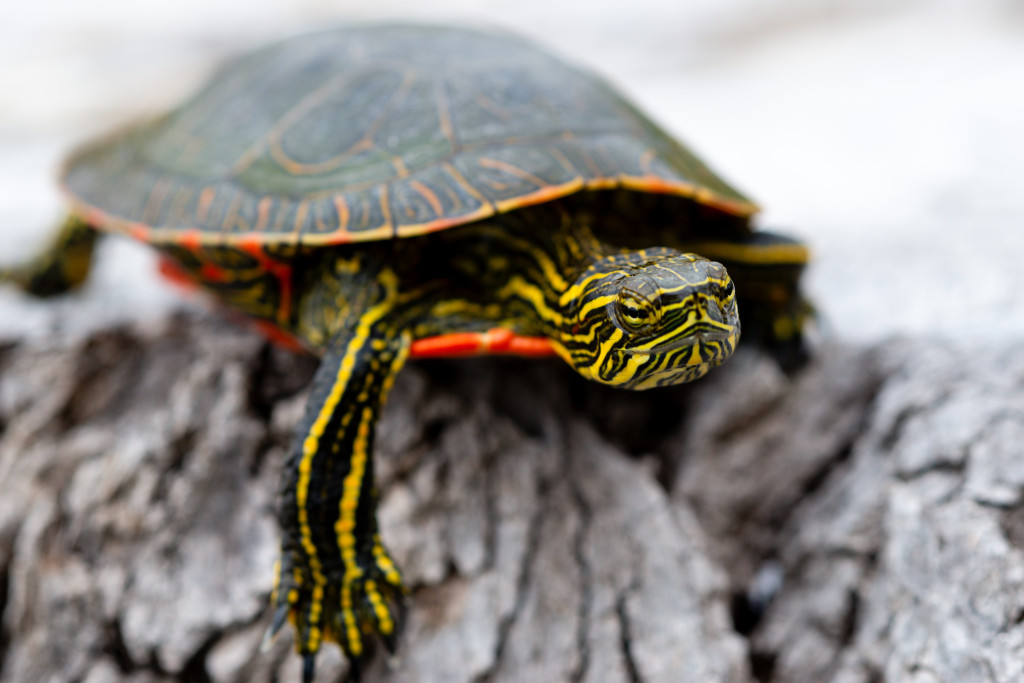
Blanding’s Turtle (Emydoidea blandingii)
The Blanding’s turtle is the happiest turtle in Nebraska, easily identified by not only its smiling face, but also the bright yellow color on its chin and throat. The carapace is higher domed than other turtles in the state, giving Blanding’s turtles a larger appearance than other species. These turtles are particularly abundant in Nebraska’s sandy streams and the Sandhills region. Other states around Nebraska only see isolated populations, where these turtles are even considered threatened and or endangered. Females of this turtle species will lay elongated leathery eggs and are active from March through mid-October.
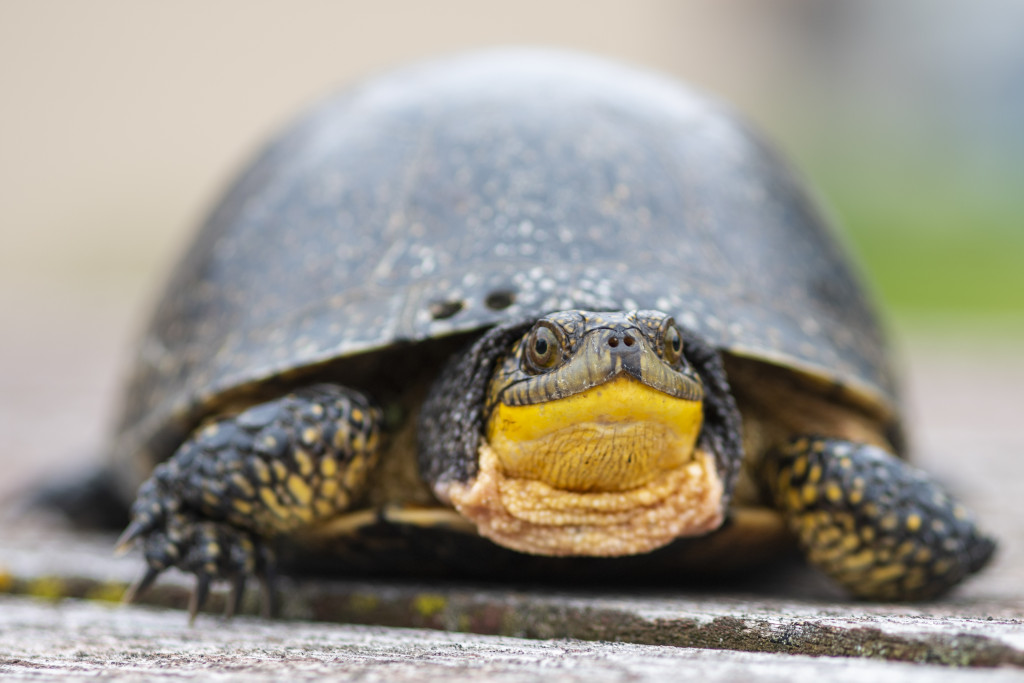
False Map Turtle (Graptemys pseudogeographica)
The false map turtle is a relatively unique species in Nebraska. This is a large river-dwelling turtle with paddle-like back feet. The false map gets its name from the lines on its carapace, which vaguely resembles a map. It is associated with rivers, streams and backwaters with lots of rocks and fallen logs to bask on. In Nebraska, false map turtles are only found along the Missouri River, including its tributaries, oxbow lakes and reservoirs. The females will often lay multiple clutches of oval-shaped eggs, which usually hatch in August. These turtles are omnivores, eating insects, insect larvae, mollusks, fish and carrion.

Ornate Box Turtle (Terrapene ornata)
This is Nebraska’s only native terrestrial turtle, and as of Oct. 28th, 2022, it is also Nebraska’s official state reptile. The ornate box turtle has a single hinge on its shell, which allows the animal to partially retract its body inside its shell for protection. Males can easily be distinguished from females in that they have red irises and are usually more colorful on the forelimbs. Females will have yellow, green or maroon irises and yellow on their forelimbs. These turtles are found in short, mixed and even tallgrass prairies, but they mostly prefer the sandy soils of the western two-thirds of the state. These turtles are also omnivores, foraging for dung beetles — their favorite, worms, arthropods, snails and small vertebrates, such as mice. They also eat succulents, rose hips and cactus fruits.
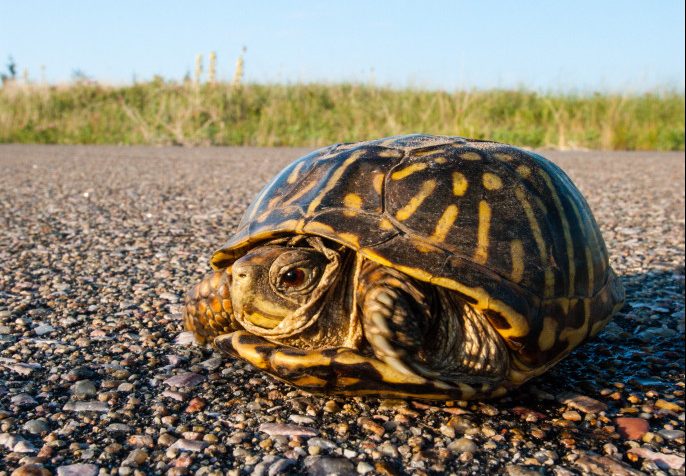
Slider (Trachemys scripta)
You may see these turtles everywhere in Nebraska, but truly native sliders are only found in the extreme southeastern parts of Nebraska. Most of the sliders people see outside this area were released pets, which have adapted and began reproducing in non-native areas. Sliders slightly resemble painted turtles, but they do not have the distinctive lines on their faces or the painted aspect on their plastrons. These pond turtles generally grow to around 7-11 inches long and can be found in permanent ponds or marshes with abundant aquatic vegetation. Like most other pond turtles, sliders have extremely long claws on their front feet, which they use during courtship rituals.
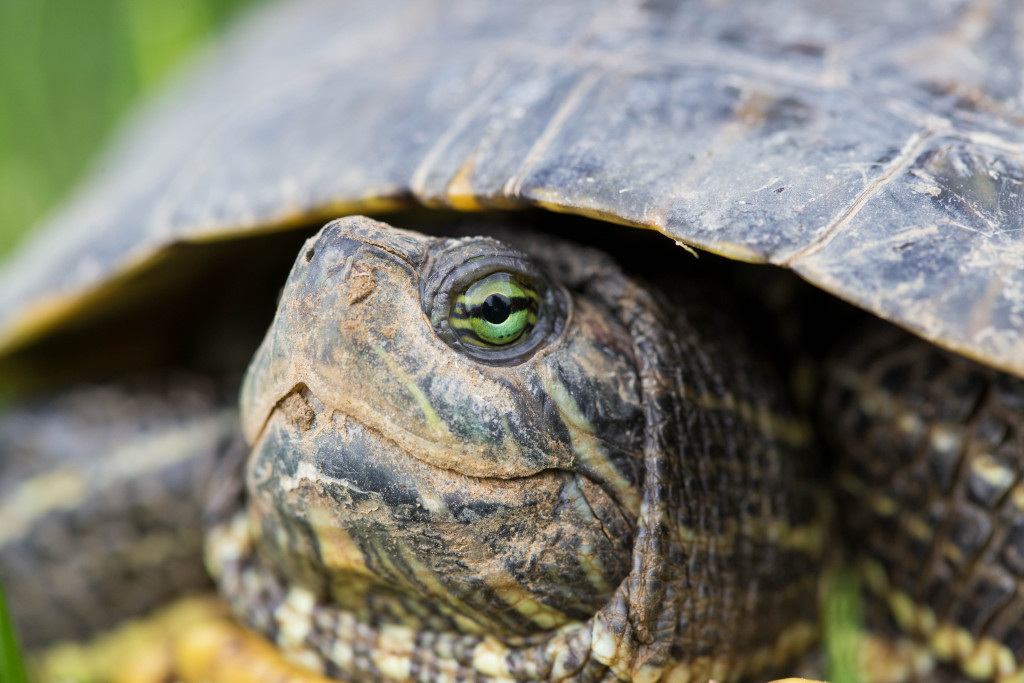
Yellow Mud Turtle (Kinosternon flavescens)
This is the only turtle in Nebraska that has two hinges on its plastron. There is no pattern on the carapace, but the plastron is yellow, giving them the name yellow mud turtle. They are active from April through October, with a brief aestivation (summer hibernation) period during July and August when they leave their aquatic habitats and migrate to upland areas to bury themselves underground. Females will lay elliptical, hard-shelled eggs that hatch between August and October. This is also the only species of turtle in the world that nests completely underground. These turtles are mainly carnivorous and feed on snails, crustaceans, earthworms, amphibian larvae, fish and carrion. When this animal feels threatened, it may release a potent odor to repel predators.
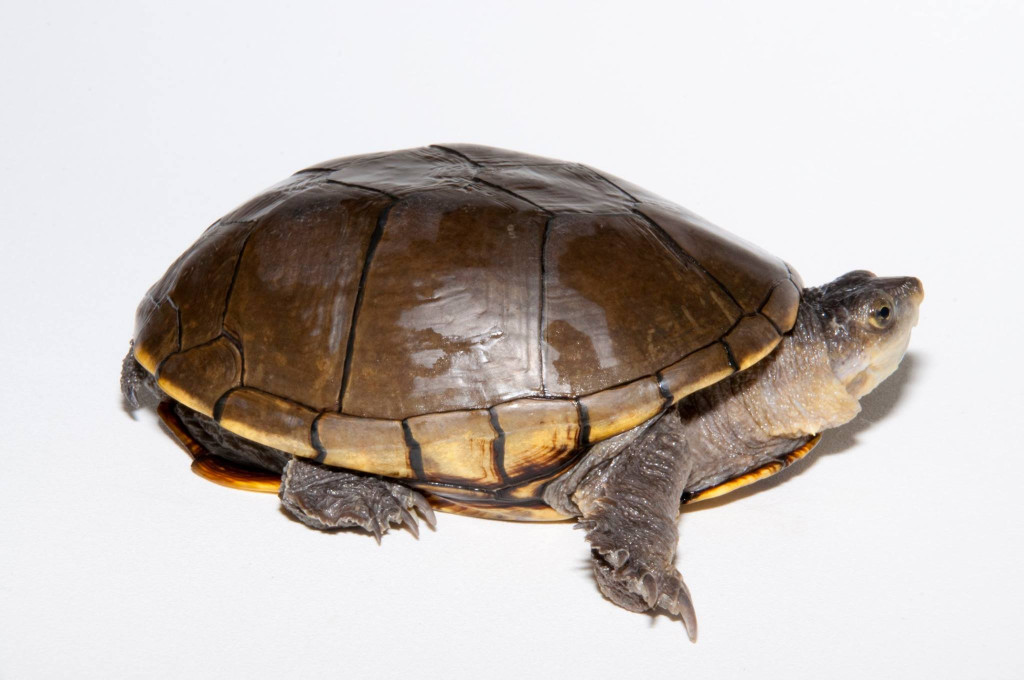
Smooth Softshell Turtle (Apalone mutica)
This is one of two softshell turtle species in Nebraska. This species is a large river-dwelling turtle that prefers sandy substrates rather than silt and is particularly picky about where it lives. Occasionally, they can be found in large lakes and reservoirs and basking on sandy shores and sandbars. Except for nesting, smooth softshell turtles rarely leave the water. Females will begin nesting in May to lay oval to round, brittle eggs and will often bury themselves in sand for a short time. These turtles feed mainly on invertebrates and can be found in the Missouri, but also the Platte, Elkhorn and Big Blue rivers.
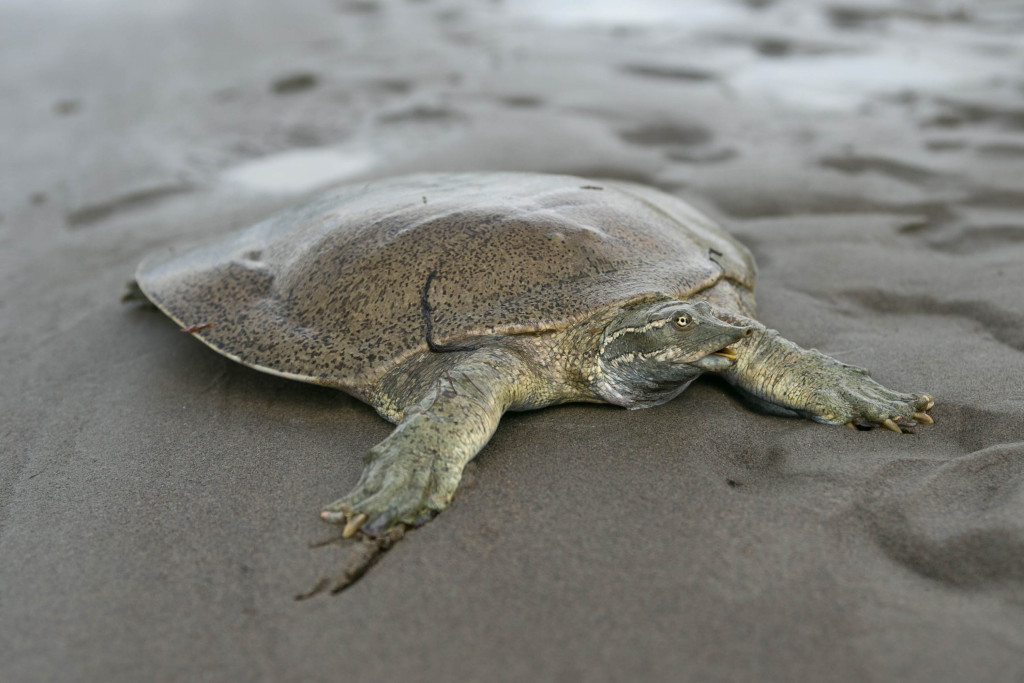
Spiny Softshell Turtle (Apalone spinifera)
This is Nebraska’s other species of softshell turtle, and it appears similarly to the smooth softshell. However, one distinguishing physical characteristic is that the spiny softshell has two rough spiny projections that extend from either side of the nasal septum; the smooth softshell lacks these nasal projections. Females and males have strong sexual dimorphism, which means that they look very different from each other — female softshells are normally substantially larger than males. The spiny softshell is a stream-dwelling species and is not as selective as the smooth softshell, which normally sticks to only rivers. Spinys usually produce two clutches of spherical, hard-shelled eggs each season.
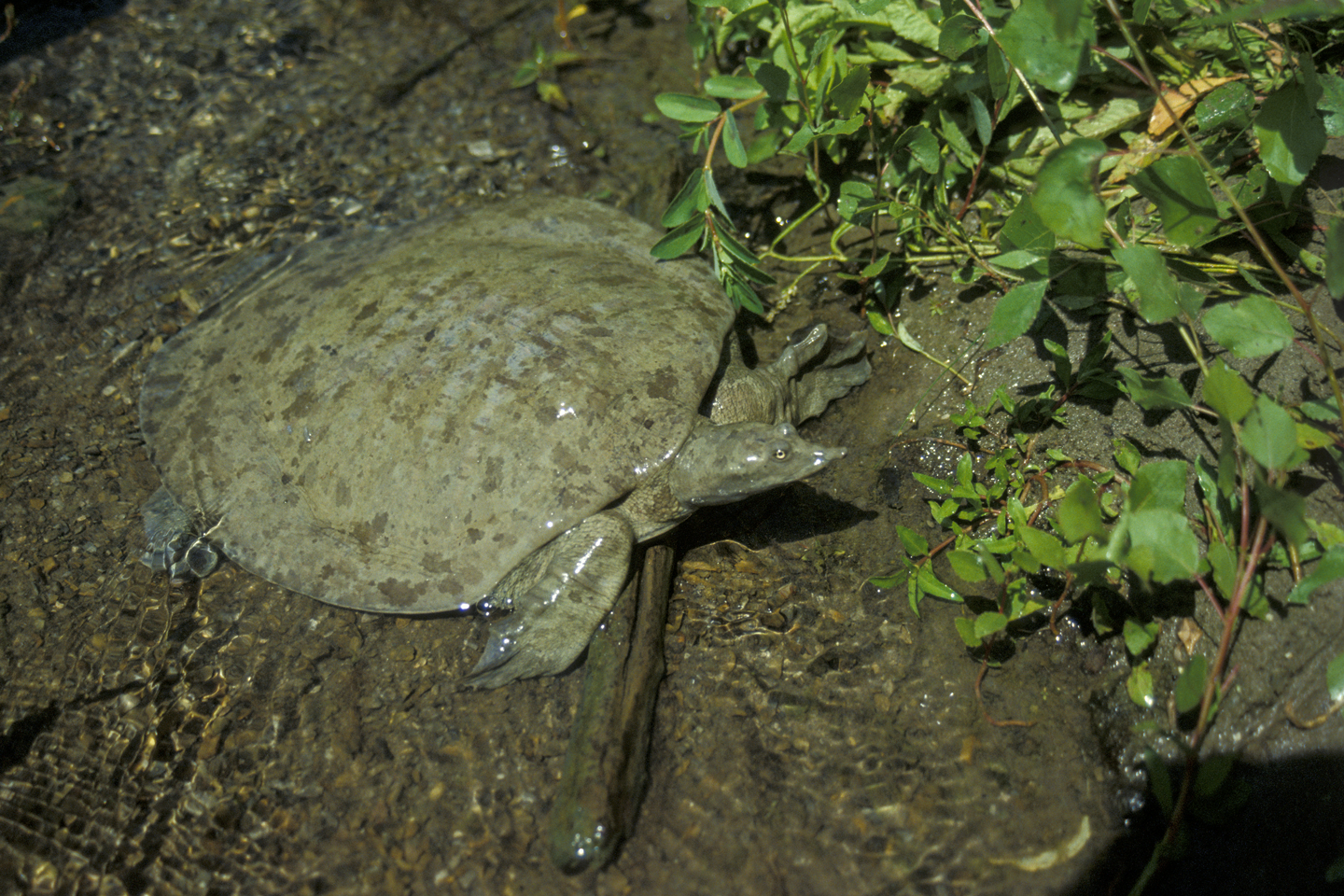
Learn more about Nebraska’s turtles at OutdoorNebraska.gov.
